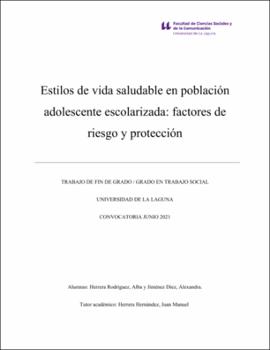Estilos de vida saludable en población adolescente escolarizada: factores de riesgo y protección.
Fecha
2021Resumen
El siguiente documento titulado: Estilo de vida saludable en población adolescente
escolarizada: factores de riesgo y protección., es un trabajo de investigación del Grado en
Trabajo Social de la Universidad de la Laguna, realizado en el curso 2020 – 2021, cuya
finalidad es conocer los estilos de vida de los/as adolescentes escolarizados/as, así como los
factores de riesgo y protección en éstos/as.
Los/as participantes han sido: 58 adolescentes de un IES del área metropolitana de
Santa Cruz de Tenerife. La metodología ha sido mediante un cuestionario elaborado (adhoc), y se ha aplicado un análisis descriptivo de las variables e indicadores y su incidencia
en éstos/as.
Los resultados principales del estudio son: la mayor parte de los/as encuestados/as
corresponden a 1º y 2º Bachillerato y en menor medida de 4º de la ESO, prevaleciendo el
género femenino con un 70,7%. Además, se ha reflejado que tienen un elevado nivel de vida
saludable, a pesar de que no duermen las horas suficientes tras acostarse tarde diariamente;
y en cuanto a los hábitos alimenticios, es importante acentuar la baja frecuencia de algunos/as
en la hora del desayuno (25,9%) y la merienda (43,1%). En relación con la tipología de
alimentos ingeridos llama la atención el hecho de que la mayoría de este colectivo comen en
en primer lugar la carne, seguido de la pasta, la verdura y los dulces; en cambio, el alimento
que menos ingieren es el pescado y otros no especificados en las opciones de la encuesta.
Además, el ejercicio físico cobra gran importancia en la salud de las personas, en este caso,
es llevado a cabo por la mayor parte de estos/as jóvenes; sin embargo, menos de su mitad no
ejecuta ni el mínimo de horas y días recomendados a la semana.
En otro orden de ideas, se acentúa la alta frecuencia de experimentación de las
diferentes drogas, con mayor hincapié en el alcohol (75,9%), el tabaco (50%) y el cannabis
(27,6%) y que, en su consumo actual estas tres también son las que se consumen en mayor
medida, concretamente el alcohol por un 55,2 %, el tabaco un 24,1% y el cannabis un 17,2%
de los/as jóvenes. Por lo contrario, la sustancia psicoactiva menos frecuente en su uso es la
heroína, comprendiendo tan solo un 1,7% del total de la muestra.
Por ende, se ha demostrado que el uso reiterado de estas adicciones es provocado por
causas como olvidarse de sus problemas, diversión, y porque el grupo de amigos/as lo hace,
y en menor medida, para ligar o por verlo en su unidad de convivencia, normalmente los
fines de semana y entre semana.
Y, por último, en cuanto a su capacidad de reacción ante situaciones adversas estos/as
jóvenes afirman estar seguros de tener la información necesaria ante posibles relaciones y
por consiguiente la prevención infecciones sexuales (43,5%), así como de saber identificar
cuando otras personas quieren hacerles sentirse inferiores e incapaces (56,9%). The following document entitled: Healthy lifestyle in the adolescent population in
school: risk and protection factors., Is a research work of the Degree in Social Work at the
University of La Laguna, carried out in the 2020-2021 academic year, whose purpose is to
know the lifestyles of the adolescents in school, as well as the risk and protective factors in
them.
The participants were: 58 adolescents from a High School in the metropolitan area of
Santa Cruz de Tenerife. The methodology has been through an elaborated questionnaire (adhoc), and a descriptive analysis of the variables and indicators and their impact on them has
been applied.
The main results of the study are: most of the respondents correspond to 1st and 2nd
Baccalaureate and to a lesser extent 4th year of ESO, prevailing the female gender with
70.7%. In addition, it has been reflected that they have a high standard of healthy life, despite
the fact that they do not sleep enough hours after going to bed late daily; As for eating habits,
it is important to emphasize the low frequency of some at breakfast time (25.9%) and snack
time (43.1%). In relation to the type of food eaten, it is striking that the majority of this group
eat meat first, followed by pasta, vegetables and sweets; On the other hand, the food that they
eat the least is fish and others not specified in the survey options. In addition, physical
exercise takes on great importance in people's health, in this case, it is carried out by most of
these young people; however, less than half do not run even the recommended minimum
hours and days per week.
In another vein, the high frequency of experimentation with different drugs is
accentuated, with greater emphasis on alcohol (75.9%), tobacco (50%) and cannabis (27.6%)
and that, in their current consumption, these three are also the ones that are consumed to a
greater extent, specifically alcohol by 55.2%, tobacco by 24.1% and cannabis by 17.2% of
young people. On the contrary, the least frequent psychoactive substance in its use is heroin,
comprising only 1.7% of the total sample.
Therefore, it has been shown that the repeated use of these addictions is caused by
causes such as forgetting their problems, having fun, and because the group of friends does
it, and to a lesser extent, to flirt or to see them in their unit of coexistence, usually on
weekends and during the week.
And, finally, in terms of their ability to react to adverse situations, these young people
claim to be sure of having the necessary information regarding possible relationships and
therefore the prevention of sexual infections (43.5%), as well as knowing how to identify
when other people want to make them feel inferior and incapable (56.9%).





